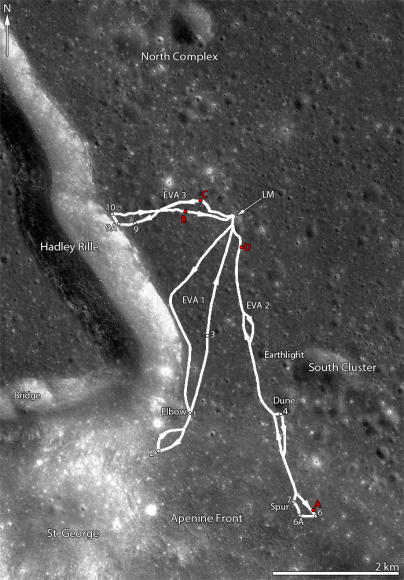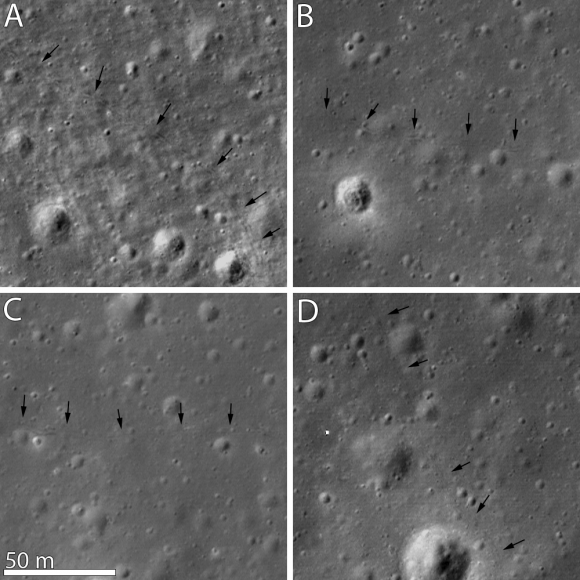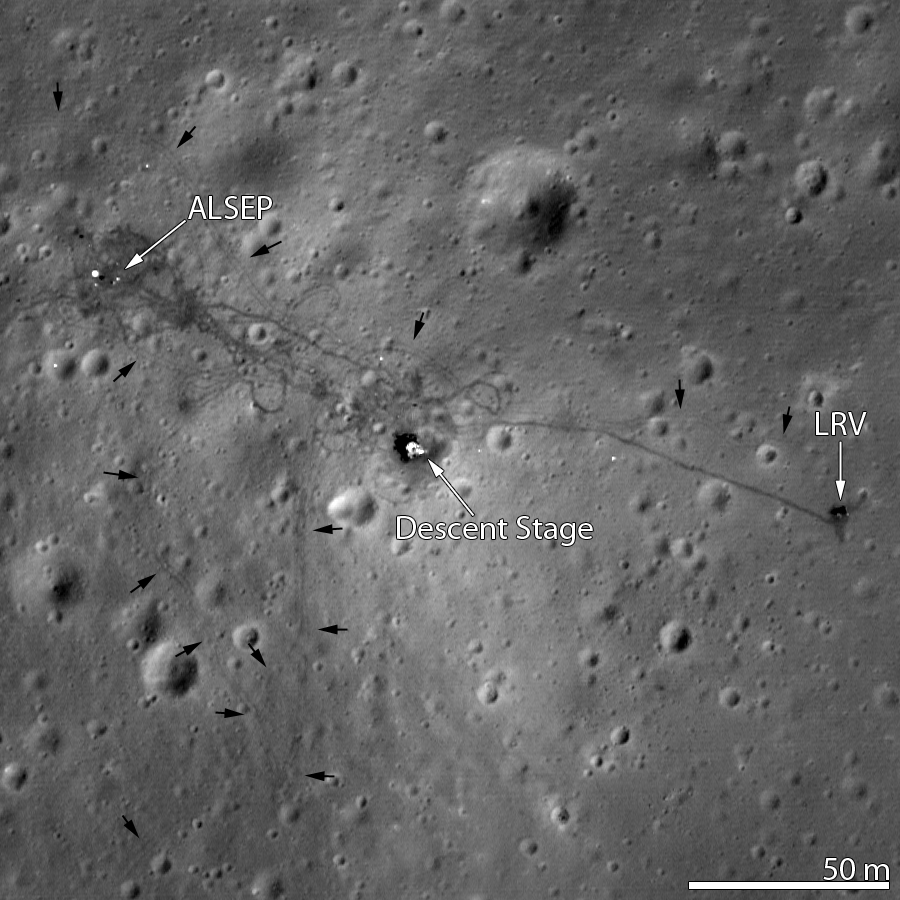[/caption]
A new image from the Lunar Reconnaissance Orbiter’s Narrow Angle Camera provides the most detailed orbital look ever at the Apollo 15 landing site on the Moon. The image of the Hadley plains shows the hardware left behind by astronauts Dave Scott and Jim Irwin and the tracks from the lunar rover.
“We like to look at the Apollo landing site images because it’s fun,” said LRO principal investigator Mark Robinson said at a briefing last year on LRO images. And these latest images are really fun, as look how clearly the lunar lander and the ‘Moon buggy’ show up! (Click images for larger views.) Additionally, we can basically follow all the movements of the rover and the astronauts during their 67-hour stay on the Moon’s surface in August of 1971.
See below for a traverse map of their rover travels.

Apollo 15 was the first mission to have the Lunar Rover, which allowed the astronauts to traverse far from the Lunar Module and explore much more local geology than the astronauts on the previous missions (Apollo 11, 12, 14).
“Not only did the LRV allow the astronauts to move from place-to-place at a lively rate of eight to sixteen kilometers per hour (five to ten miles per hour), but the LRV also allowed brief periods of rest that in turn helped to conserve oxygen,” said Robinson on the LROC website.
The goals of Apollo 15 were to sample the basalts in the region, search for ancient crustal rocks and explore a lunar rille for the first time – the long, narrow depressions in the lunar surface that resemble channels. Additionally, Scott and Irwin deployed the third Apollo Lunar Surface Experiments Package (ALSEP), which consisted of several experiments that were powered by a Radioisotope Thermoelectric Generator (RTG) and sent back valuable scientific data to the Earth for over six years after the astronauts left.

Robinson and his team can figure out the details of what pieces of equipment are in each location by comparing what they see in orbital images to images taken from the surface by the astronauts.
One of the most commonly asked questions is if the flags left on the Moon are still visible.
“All we can really see is the spots where the flag was planted because the astronauts tramped down the regolith,” Robinson said last year. “I’m not sure if the flags still exist, given the extreme heat and cold cycle and the harsh UV environment. The flags were made of nylon, and personally I would be surprised if anything was left of them since it has been over 40 years since they were left on the Moon and the flags we have here on Earth fade after they are left outside for one summer. If the flags are still there they are probably in pretty rough shape.”
For two one-month periods last year (2011), the LRO orbit was lowered such that overflights of the Apollo sites were only 25 to 30 kilometers, rather than the usual 50 kilometers. These low passes resulted in NAC pixel scales near 25 centimeters, Robinson said. “LRO has a ground speed of a bit over 1600 meters (5249 feet) per second, and the shortest NAC exposure time is 0.34 millseconds, so images taken from this low altitude are smeared down track a bit. However, the smear is hardly noticeable and features at the Apollo sites definitely come into sharper focus. In this new low-altitude NAC image of the LRV, tracks are visible about half of the time, usually when the tracks are at an angle to the Sun direction, rather than parallel,” he said.
You can see the close-up images of the Apollo 12, 14 and 17 at a previous article on Universe Today.
Source: LROC website


Nice..
These are CLEARLY Photoshopped. (is what I would say if I was crazy)
This is pretty damning evidence for those who still claim that the moon landings were faked.
Didnt you know?
Nasa had to do the Moon-landings for real because faking it would cost even more.
1. They already had to build the rocket, or people would question how the astronauts got there.
2. Catering for an entire film-crew and actors greatly exceeded the catering for 3 astronauts.
3. Securing a filmingarea and keeping trespassers away would require catering also for that army.
Making a movie is expensive business 😛
it amazes me how a conspiracy theory that is so laughably misguided can be so popular, prevalent and have such longevity. Its funny when they try to use physics to try to prove we never went when in reality they are proving that we did! (ie, shadows, dust, clear horizon, ect the list goes on…) that said,
these picture are very impressive and a testament to the teams who designed, built and operate LRO
About ten years ago, the guy delivering my home-heating fuel told me that he had a $1,000 bet with a friend that the Moon landings never happened. The weird part was that he is my age, and I recall very clearly where I was and what I was doing at the moment that Armstrong became famous forever.
I should send him these photos. On the other hand, nothing will make the hoax believers admit they were wrong.
People like us know the truth about the moon landings and I will always be grateful that I was able to witness history’s defining moment.
In grade school I became entralled by the fact we were going to the moon. I ended up watching one of the Apollo-Saturn launches. In later life working on astro-dynamics I saw a shuttle launch and deltas goes up. The Saturn V was impressive, and the rocket plume was incredibly bright, almost hard to look at, and the sound was akin to a thousand of those morter rounds in fire works that give a loud report going off every second. It had a far sharper sound than the shuttle does. It would have cost about as much to fake all of this as to actually do it. The staging of the rocket could be seen with the naked eye, and the whole craft is moving probably 1 to 2 kilometer/sec.
I am not sure what is behind the moon hoax stuff. I suspect it is just a part of this general dumbing down of the American mind, where we have a social dialogue of confusion that includes so called creation science, climate denialism and so forth.
LC
According to this BBC News article: “People are also more likely to believe in conspiracy theories if they feel powerless in the face of large social authorities or institutions, and not part of the mainstream of society.”
About the flags, amazingly enough, the ones for Apollo 12, 16 and 17 are still aloft and casting shadows through the lunar day as can be viewed in these links to animated GIFs of the LRO images.
http://interestingnasadiscoveries.wordpress.com/2011/10/06/apollo-12-flag-still-flying/
http://interestingnasadiscoveries.wordpress.com/2011/10/06/apollo-16-flag-still-flying/
http://interestingnasadiscoveries.wordpress.com/2011/10/06/apollo-17-flag-still-flying/
Great photos, it would be good if man could get back there sometime soon.